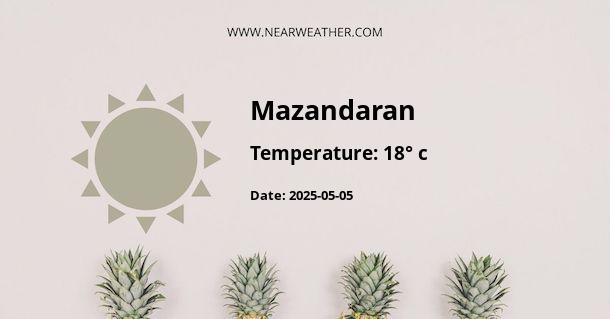A Comprehensive Guide to the Climate and Weather in Ostān-e Māzandarān, Iran
Located in the northern part of Iran, Ostān-e Māzandarān is a region graced with a unique blend of natural beauty and a rich culture. Its diverse geographical make-up, which includes coastal plains, rugged mountains, and dense forests, contribute significantly to its equally diverse climate. This article provides a detailed, year-round description of the weather and climate in Ostān-e Māzandarān.
Overview of Ostān-e Māzandarān's Climate
Ostān-e Māzandarān experiences a humid subtropical climate, with warm, humid summers and mild, wet winters. The region's proximity to the Caspian Sea greatly influences its climate, leading to high humidity and significant precipitation throughout the year.
Temperature
The average annual temperature in Ostān-e Māzandarān is about 16°C. The warmest month is typically August, with an average temperature of 26°C, while the coolest month is January, with an average temperature of 6°C.
Precipitation
Ostān-e Māzandarān is one of the rainiest provinces in Iran due to its geographical location and the influence of the Caspian Sea. The region receives an average annual rainfall of around 1200mm, with the highest precipitation occurring from October to January.
Weather in Ostān-e Māzandarān Throughout the Year
Winter (December - February)
Winter in Ostān-e Māzandarān is typically mild and wet. Average temperatures range from 5-10°C. The region receives the majority of its annual rainfall during these months, with frequent showers and heavy downpours, contributing to its lush green landscapes.
Spring (March - May)
Spring is one of the best times to visit Ostān-e Māzandarān. The weather is generally pleasant with average temperatures fluctuating between 11-20°C. The region comes to life with blooming flowers and lush vegetation, thanks to the ample rain from the preceding winter months.
Summer (June - August)
Summers in Ostān-e Māzandarān are warm and humid. Average temperatures hover around 25°C, but can reach up to 30°C on particularly hot days. Despite the warmth, summer is also marked by frequent showers, though not as heavy as in the winter months.
Autumn (September - November)
Autumn sees a gradual decrease in temperature, with averages falling between 10-20°C. Rainfall begins to increase again towards the end of autumn, signaling the onset of the wet winter season.
Climate Considerations for Visitors
"Ostān-e Māzandarān's climate, with its high humidity and significant rainfall, requires visitors to be prepared for wet conditions throughout much of the year. It's advisable to pack rain-resistant clothing and footwear. The region's summer can be particularly warm, so lightweight, breathable clothing is recommended during this season."
Conclusion
In conclusion, Ostān-e Māzandarān's climate is a reflection of its diverse geographical make-up. The influence of the Caspian Sea, combined with the region's varying topography, results in a humid subtropical climate characterized by warm, humid summers and mild, wet winters. This unique climate contributes to the region's rich biodiversity and lush landscapes, making it a captivating destination for visitors.
A - Mazandaran's Latitude is 36.250000 & Longitude is 52.333328.
A - Weather in Mazandaran is 5° today.
A - Climate Conditions in Mazandaran shows light rain today.
A - Humidity in Mazandaran is 96% today.
A - Wind speed in Mazandaran is 3.06 km/h, flowing at 26° wind direction. today.
